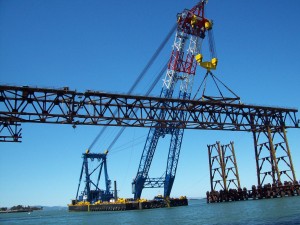As we’ve already mentioned in our last article, there are many benefits to placing cameras on cranes. These cameras make it possible for the crane operator to see in places that were considered blind spots before. As you can imagine, lifting and moving loads which weigh several hundred pounds can be extremely dangerous in the best conditions. It becomes even more so when the crane operator cannot see where the load is being lifted from, or moved to.
Cameras added to the crane allows the operator to simply glance at a monitor to see exactly where his load is at any time. You can see why this would be beneficial to the operator, and to anyone on the job site that could be affected by an accident. Another, unintended benefit of placing cameras on cranes at your job site is increased productivity. Workers tend to work harder and be more productive when they think that they are being watched. This is, however, an unintended benefit, as these cameras are not actually designed to watch the crew, they are designed to give extra eyes on the load to the crane operator.
Unfortunately, there are many worries on the minds of those working at the site when they see cameras on cranes. Many may feel that the cameras were placed there for the sole purpose of management watching them work, and see it as an invasion of privacy. If they are not aware of how beneficial these cameras are and how they work, the workers could dwell on their existence. This can cause anxiety, bitterness, and anger on the job site. In some cases, workers could actually sabotage the equipment if they allow those fears to fester. Let’s see if we can put that worry to rest.
The easiest way to lay to rest those fears about cameras on cranes among your crew is education. They should be taught the benefits of having cameras on cranes, and learn exactly how these cameras work. They are not designed to spy on the worker. They were created to add an abundance of safety to the job site that was just not available before their creation. Removing blind spots and blind lifts reduces the risk of accidents, which can save a great deal of time and money, and could even save lives. Safety, after all, is the number one goal on any job site, and these cameras make it possible to reach that goal.
Creating the ability for the crane operator to be able to see the load anywhere on the job site removes the risk of a blind lift that crashes into equipment, buildings, or even people. It gives added confidence to the crane operator, which gives him the ability to make better, more beneficial decisions when making a lift. That confidence is crucial on the job site. After all, who wants a shaky crane operator? And when the crane operator is confident in his work that confidence is passed on down through the crew, who learns to trust him and his decisions. This trust is crucial in these types of work environments, and with these cameras, it becomes a real possibility. So as you can see there is no negative aspect to these cameras. They increase safety, productivity, and confidence among the crew, and reduce accidents, costs, and loss of life. Now how could that ever be a bad idea?


